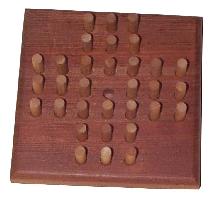peg solitaire

Peg solitaire, also known as Hi-Q, is a game that, in its commonest form, is played with 32 pegs or marbles on a rectangular grid, the middle position of which starts out empty. A peg may jump horizontally or vertically, but not diagonally, over a peg in an adjacent square into a vacant square immediately beyond. The peg that was jumped over is then removed. The object is to be left with a single peg in the center position.
| 1 | 2 | 3 | 4 | 5 | 6 | 7 | |
| 1 | + | + | + | ||||
| 2 | + | + | + | ||||
| 3 | + | + | + | + | + | + | + |
| 4 | + | + | + | + | + | + | |
| 5 | + | + | + | + | + | + | + |
| 6 | + | + | + | ||||
| 7 | + | + | + |
The quickest solution of Solitaire was found by Ernest Bergholt in 1912 and was proved to be minimal by John Beasley in 1964. It involves the following moves:
46 → 44.
65 → 45.
57 → 55.
54 → 56.
52 → 54.
73 → 53.
43 → 63.
75 → 73 → 53.
35 → 55.
15 → 35.
23 → 43 → 63 → 65 → 45 → 25.
37 → 57 → 55 → 53.
31 → 33.
34 → 32.
51 → 31 → 33.
13 → 15 → 35.
36 → 34 → 32 → 52 → 54 → 34.
24 → 44.
Reference
1, Beasley, John D. The Ins and Outs of Peg Solitaire. New York: Oxford University Press, 1985.


